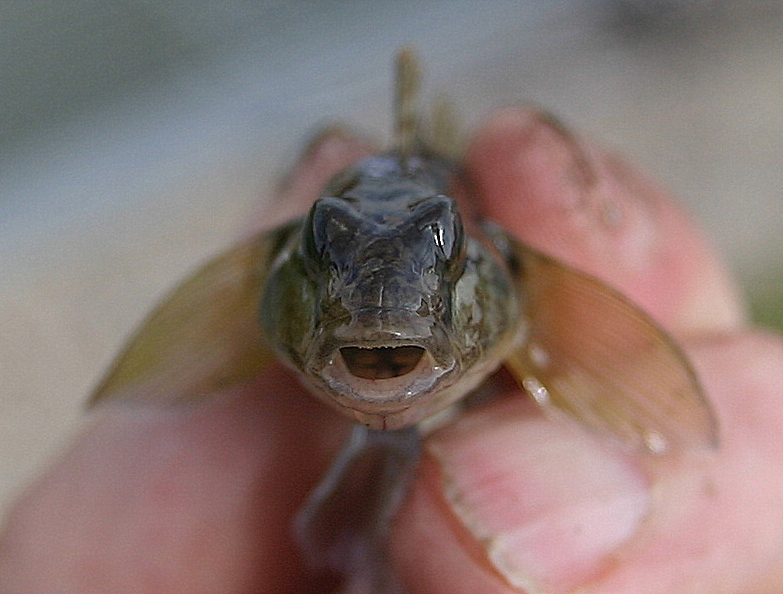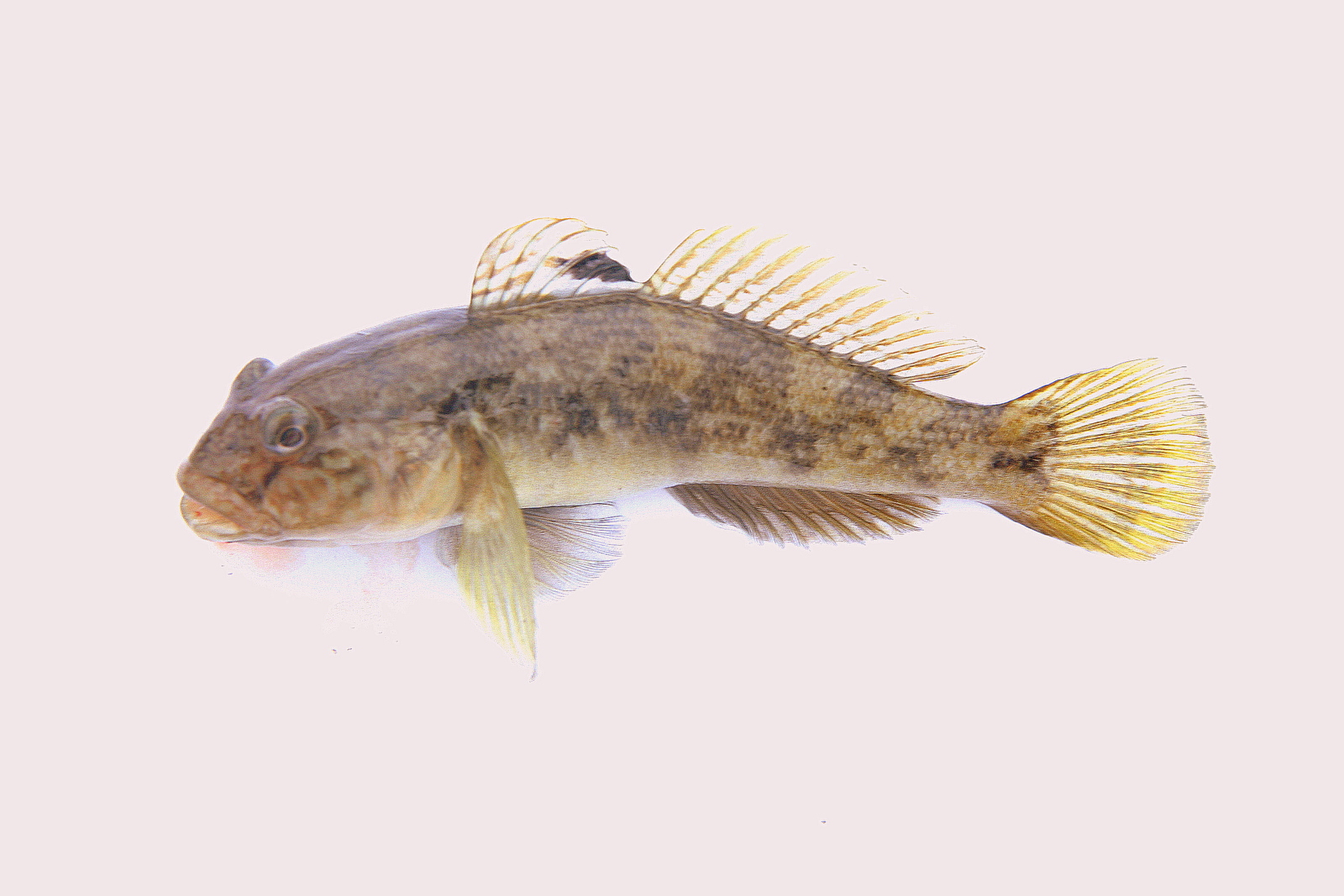Conservation Conundrum
What happens when a devastating invasive fish benefits one of Lake Ontario's most vulnerable populations?
By Arianna Paquette
When the round goby – a fleshy, villainous fish with a reputation for destruction – first showed up in Lake Ontario in the 1990s, scientists were dismayed. The goby, which hails from the Black Sea, soon began to gobble up native fish eggs and competing with them for resources, which led to an enormous decrease in some fish populations. After more than two decades into their invasion, one fish seems to have benefitted from the goby populations: the lake sturgeon, a vulnerable fish native to Lake Ontario, who developed an overwhelming preference and reliance on eating the gobies.
But for other native fish, who have been negatively impacted by the goby’s presence, this relationship is anything but positive. In many cases, the intentional or unintentional introduction of an invasive species in a new place wreaks havoc on existing ecosystems: they displace vulnerable native species, destroy native plants, and could even cause adverse effects to people.
Scientists classify a species as invasive when it has been newly-introduced to an ecosystem, and causes environmental and ecological damage to this ecosystem. Invasive species in Canada are no exception to this destruction. The economic effects of invasive species in the Great Lakes total up to $200 million annually.
Now, a study published in the journal Biological Invasions gives new insight into a possibly positive aspect of a relationship between a native fish and an aggressive invasive fish species in Lake Ontario and the Niagara Lakes region.
“When you have a species invader, they do all sorts of things: good, bad, weird. But if you can get a handle on even a positive effect, then that’s what you can use to go forward and study the effects,” says lead researcher Gregory Jacobs, an ecologist at the Odum School of Ecology in Athens, Georgia.
Gregory says that the beneficial relationship between adult lake sturgeon and round gobies is a difficulty area to navigate, because it is difficult to weigh the pros and cons of the goby. The study was a conservation effort of the lake sturgeon, a vulnerable native fish species that lives in the Great Lakes, and the round goby, an insidious invader fish from Eastern Europe.
Gregory conducted part of the study that looked at the diet of lake sturgeon. They found that the goby was actually a crucial part of the sturgeon’s diet, and may actually be a factor in the population growth of the sturgeon. But gobies are still invasive, and do cause damage on the ecosystem, leading to a difficult predicament for conservation efforts.
“When you have a species invader, they do all sorts of things: good, bad, weird. But if you can get a handle on even a positive effect, then that’s what you can use to go forward and study the effects.” – Gregory Jacobs.
The sturgeon as a species at risk
The sturgeon is a bottom feeder, and eats snails, clams, and fish eggs. They are enormous, growing up to seven feet and weighing over 200 pounds. Often nicknamed dinosaur fish, they can trace their roots back 200 million years, during a time when dinosaurs still walked the earth. They are also the only sturgeon species native to the Great Lakes.
Although they can live up to 100 years, sturgeon only reach sexual maturity after several decades, and can only produce a few offspring every four to nine years, in contrast to many other fish species, who can annually produce hundreds of offspring.
According to the U.S. Fish and Wildlife Service, who also monitor lake sturgeon in Lake Michigan, only 10-20 per cent of adult lake sturgeon spawn per season. Another factor in their decline is change or loss of habitat, due to overfishing, dams that change water levels and speeds, pollutants in the water, and habitat damage due to unsustainable agricultural practices.
These two factors, low reproduction rate, and changing habitat have led to the threatened Lake Ontario Lake Sturgeon to be put on the “Species at Risk” list.
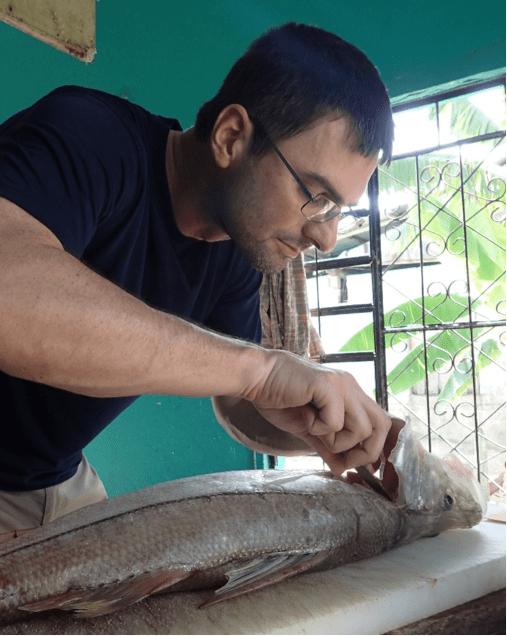
A photo of Greg Jacobs analyzing lake sturgeon spines to get a better understanding of their diet. Source: Wenger Lab, University of Georgia. [Photo courtesy of Greg Jacobs]
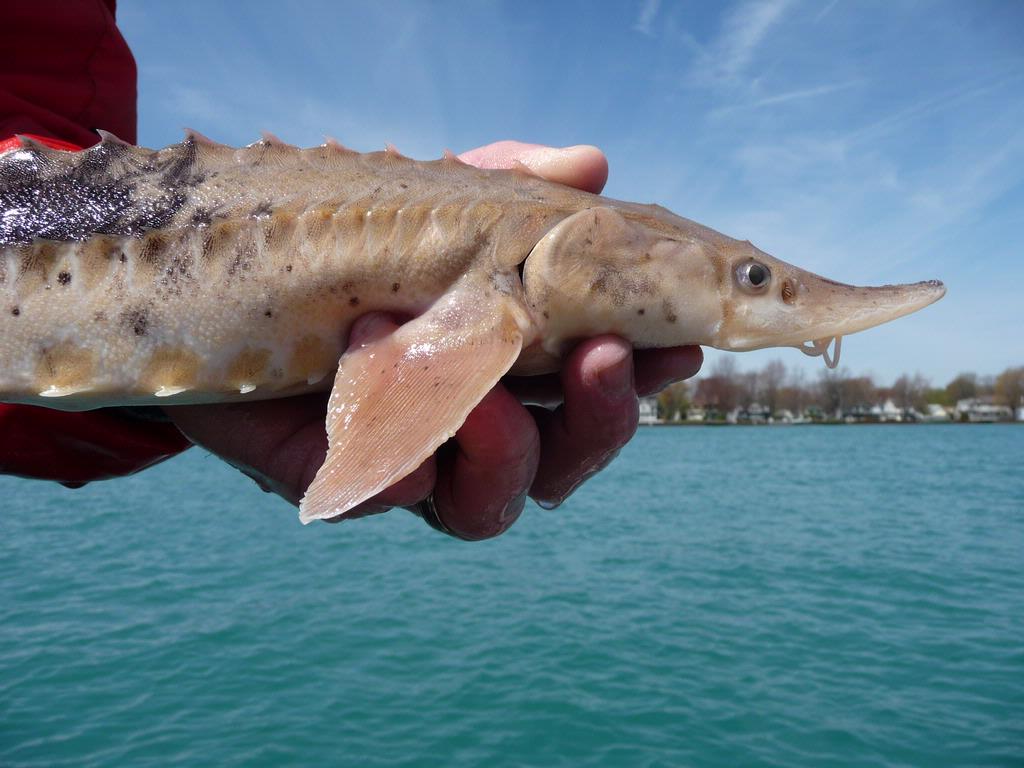
A juvenile lake sturgeon. [Photo © U.S. Fish and Wildlife Services, licensed under CC-BY 2.0 license]
The origin of the goby
Like the lake sturgeon, the round goby is a bottom-dweller, making it easy prey for the sturgeon. Gobies are native to the Black and Caspian sea regions, off the coast of Russia and Western Asia. They were first documented in the Great Lakes regions in the 1990s, having been transported by the water that cargo ships keep in their hulls to increase stability.
As the ships scooped up water in the goby’s native regions, it also scooped up baby gobies, which live on the surface. When the cargo ships passed into the Great Lakes, they released the now-mature gobies into a new ecosystem. Part of the gobies’ success can be attributed to their durability: they can live easily in low quality-water, and spawn frequently.
Gregory conducted this study as part of his work with the U.S. Fish and Wildlife Service. He says that the study always had conservation as its primary goal, but looking at the populations of lake sturgeon was a big obstacle.
“We were always interested in conserving this big dinosaur fish that has continued to survive in the Great Lakes for about as long as we’ve been here,” Gregory explains. “But they are just rare enough that it’s hard to get a real handle on how they’re doing.” The study examined the spines of lake sturgeon, which give information about the types of foods that sturgeons eat. Lake sturgeon captured in 2014 were shown to have an overwhelming preference or reliance on gobies.
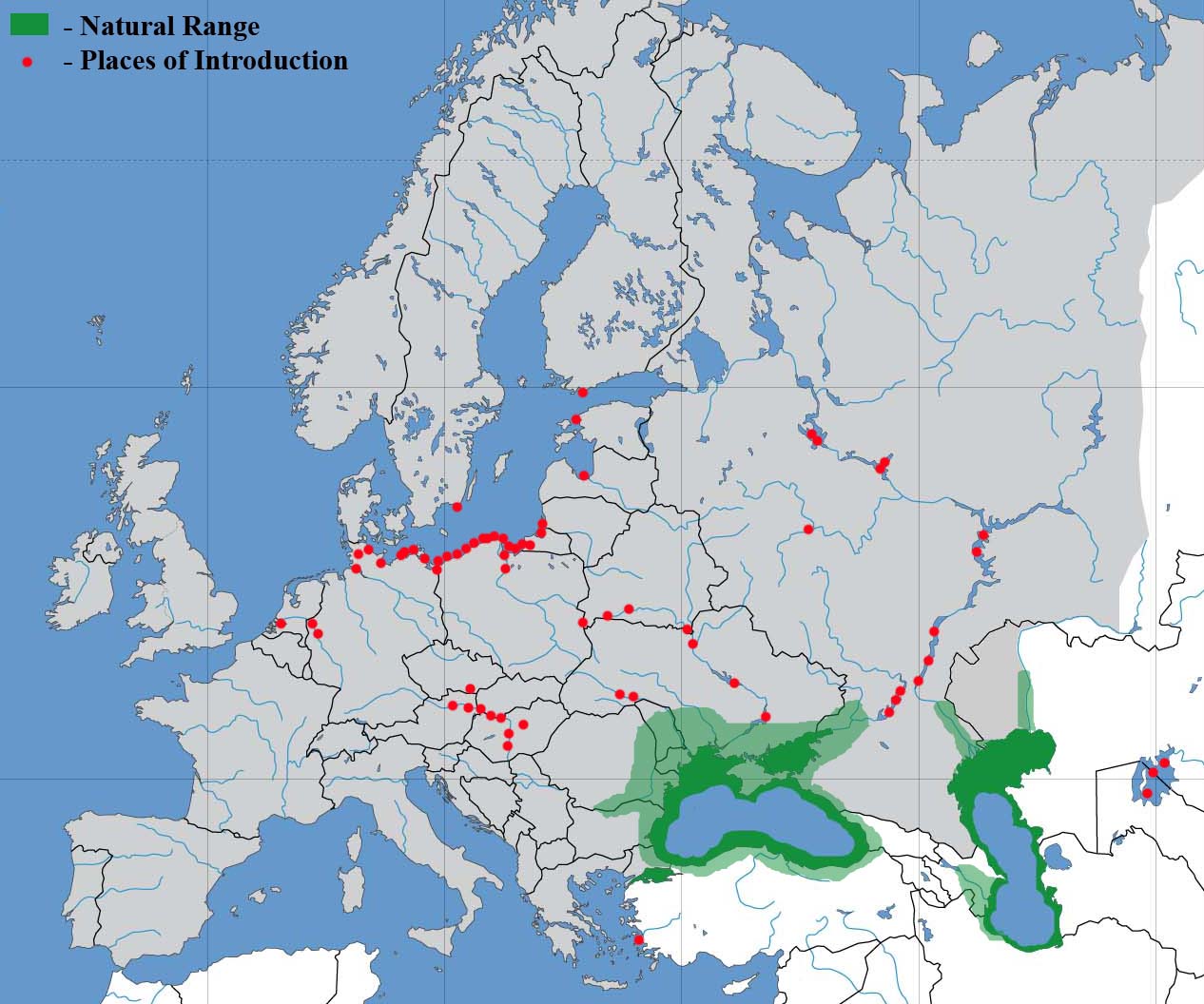
A map showing the round goby’s original range in green, before their introduction to the Great Lakes in the 1990s. [Photo © Yuriy Kvach, licensed under CC-BY 4.0 license]
But gobies are still considered an invasive species, and measures are in place to control their populations. Great Lakes Organizations have many methods of controlling the population of gobies. The Ontario government has currently banned the possession of live gobies, and the use of the gobies as baitfish for sturgeon or other types of fish.
Lake Michigan fisheries have cargo water regulations, but there is currently no way of stopping or completely eradicating the goby populations in the Great Lakes. Unfortunately for many native fish species, the goby is a vicious invader. Not only does the goby outcompete with other native bottom-feeding species, like the sculpin, the johnny darter and the log perch populations, it also eats the native fish eggs, leading to even more of a decrease in native fish population.
On appearances alone, the goby seems perfect to play the villainous invasive species. Although only 30 centimetres long, it has jagged teeth, an enormous mouth and sharp fins. On the contrary, the docile lake sturgeon, with its mustache-like barbels, looks more like a kindly grandfather.
Small fractions: Understanding the pros and cons of the lake sturgeon and goby relationship
But the predator-prey relationship between the vulnerable sturgeon and the invasive goby is cause for some concern. “You get a terrible balance that happens where species can be positively influencing some things, and negatively influencing others,” Joseph Bennett, an ecology professor at Carleton University, whose research is concentrated on invasive species management, declares. “In some cases, invasive or exotic species may do some good for a small fraction of the population.” “Small fraction” are the key words here, Joseph emphasizes.
It is important to keep in mind that the goby is not an overly positive introduction to the Great Lakes, despite the fact that it may have a small positive relationship with lake sturgeon.
But according to Gregory, the gobies are not fully beneficial to all ages of lake sturgeon. They could still be a threat to younger sturgeon. “They could prey on eggs, act as competitors for young lake sturgeon for space and food, basically what they’re done to other fish species,” Gregory warns. “But they seem to be an important food staple for vulnerable adult populations of lake sturgeon.”
This conclusion leads to an important question, which Joseph calls a “conservation conundrum.” How do we live with, or control invasive species? “I think that the solutions are far more complex than just these two options,” Joseph suggests. “If something is doing harm to one thing, but is good for another, then it really depends on management priorities, and that’s a really tough conundrum to be part of.”
There is a high degree of overlap between the Fisheries and Oceans Canada and the U.S. Fish and Wildlife Service, who control the Canadian and American Great Lakes, respectively. The 2011 recovery strategy for lake sturgeon in Ontario is to maintain existing populations throughout their current range and also to conserve existing populations. The strategy also recommends protecting areas important to the Lake Sturgeon, particularly in Northwestern Ontario, the Great Lakes region, and the Upper St. Lawrence River.
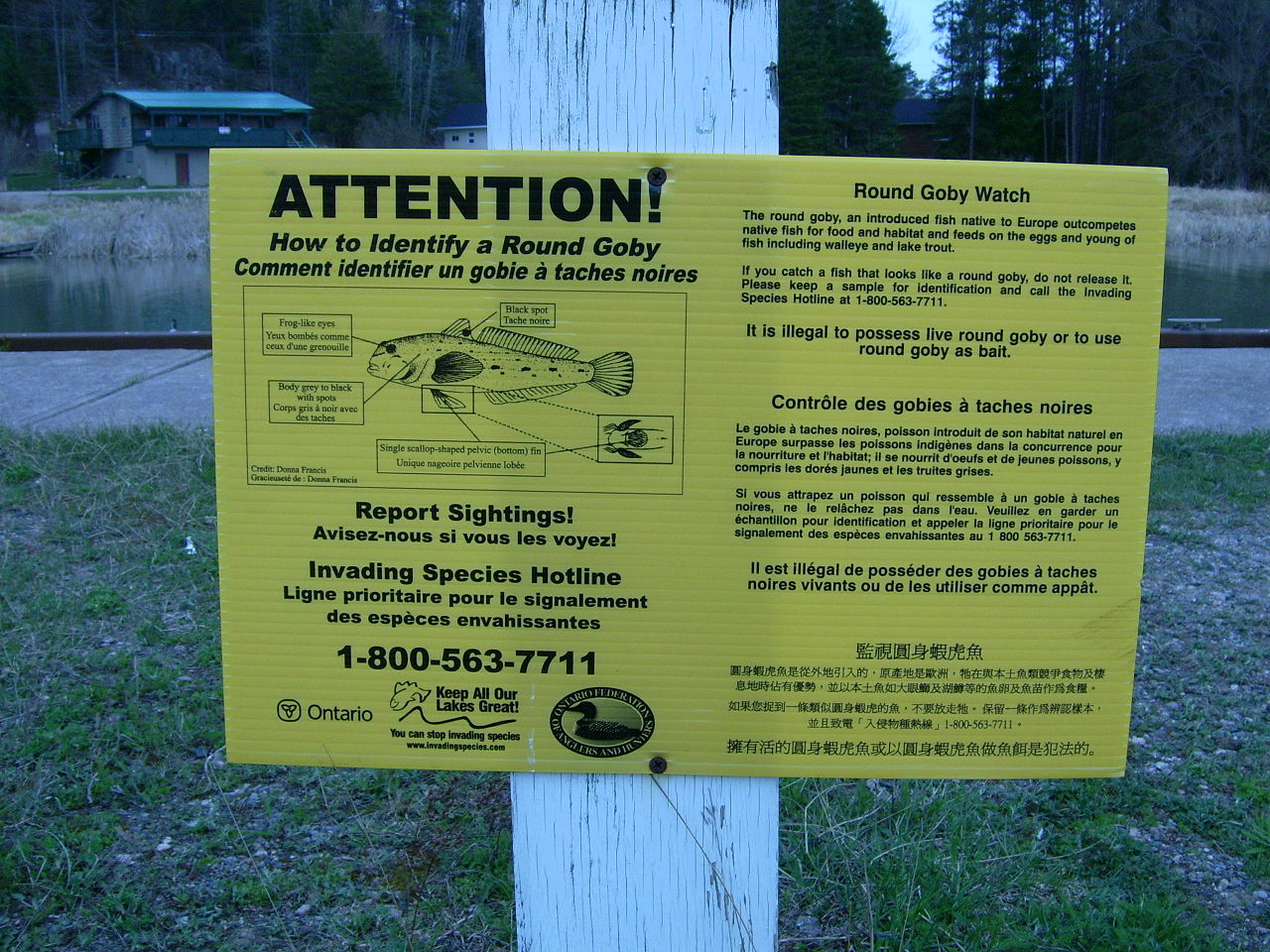
A warning sign that bans the use of goby as live bait, as well as information on how to identify gobies. [Photo © Fungus Guy licensed under CC-BY 3.0 license]
A gallery of round gobies. [All photos © Peter van der Sluijs, licensed under CC-BY 3.0 license]
A similar story: gobies and smallmouth bass
Biologist Derek Crane conducted a similar study with round gobies and native smallmouth bass in Lake Erie. The carnivorous smallmouth bass eats crayfish, insects and other fish. Like the lake sturgeon, gobies are a crucial part of the smallmouth bass diet.
But he believes that policymakers tend to drag their feet in invasive species management, which could lead to more negative effects. “Usually, by the time policy makers demonize an invasive species, the species is already well-established and potentially negatively affecting native species,” he explains.
Derek’s smallmouth bass study also came to the same conclusion as Gregory’s lake sturgeon one: that the small benefits of gobies for adults may negated by their adverse effect to eggs and babies. “Although our study demonstrated a benefit for one aspect of the smallmouth bass’ life history, consumption of round goby may allow for higher survival from the juvenile stage to maturity, the benefits of increased survival may be offset by consumption of smallmouth bass eggs by round goby,” says Derek.
While the goby’s introduction is in no way a positive event, there may be a silver lining for some adult species of vulnerable and mature native fish. However, this silver lining must be balanced with the damage that gobies cause to other native fish species.
Here is a video of a population of round gobies devouring a smallmouth bass nest. Although gobies are an important part of the adult smallmouth bass diet, they still have a negative effect on the population.
Next steps
But Gregory is optimistic in this study, and hopes that it can further conservation efforts for the lake sturgeon. He says that his next steps in this study would be to synthesize all their information, and try and figure out when they can loosen restrictions on lake sturgeon fishing, and get the Lake Ontario sturgeon to a place where they can be safely and sustainably fished.
Ecology and invasive species management problems are rarely clear cut or rarely black and white, and the beneficial relationship between the goby and the sturgeon is, for now, a gray area in terms of how to continue. The goby, however, are still classified as a dangerous invasive species, and the Ontario government continues their ban on owning live gobies.
Joseph explains that these kind of invasive and native species relationships are difficult to address, because of the positive and negative effects that invasive species cause. This makes it even more difficult for scientists and ecologists to predict, and for policymakers to figure out what to do. But Joseph says that the first step is being wary. “It’s important to be cautious,” he says. “Often in exotic species, the initial stages usually show that the species if okay now, and could even be helping something now, but that could always change in the future.”

